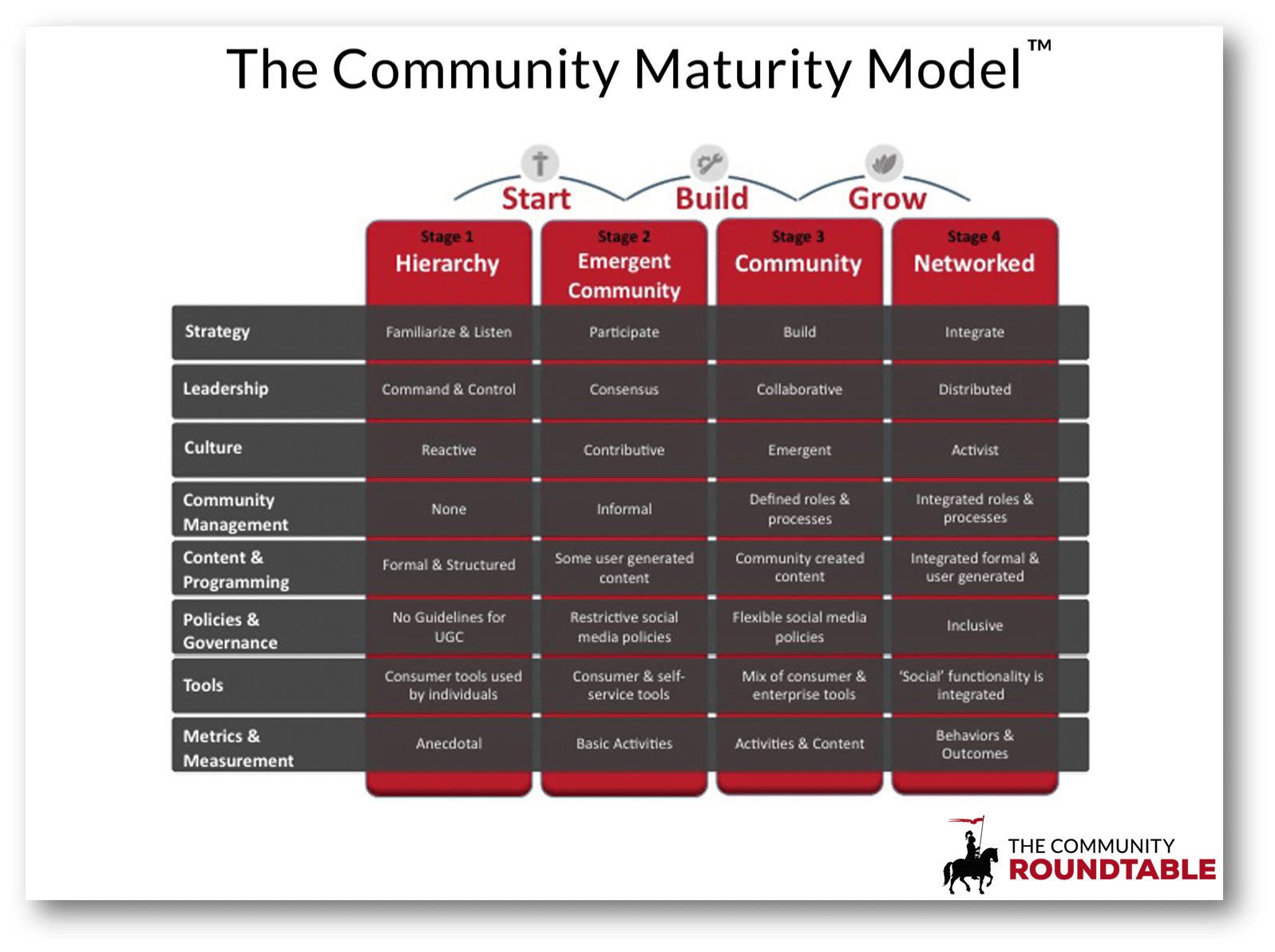
We developed the Community Maturity Model (CMM) to help community leaders and their organizations understand,plan for, and assess the performance of their community and social business initiatives.
The CMM organizes the issues, associated competencies, and information relevant to community management as the discipline matures and extends across an enterprise. It aligns on two axes: maturity levels and competencies.
Let’s take a deep dive into the stages that define community maturity levels.
These stages refer primarily to the information and relationship environment of an organization. While these maturity stages are a continuum, certain behaviors emerge as established patterns of particular stages.
Stage 1: Hierarchy: ad hoc use of social technology or community structures.
Organizations in CMM1 (Community Maturity Model, Stage 1) can range from those relatively untouched by social technologies and methods to those with a chaotic jumble of different teams using different technologies with an inconsistent understanding of the opportunity, risks, challenges, needs or interests of the organization.
Individuals in this environment are typically left on their own to figure how community approaches can help them. In this stage, community can often been seen as a short-term productivity drain, as people learn and often reinvent the community wheel.
Management in this environment often sees community as a distraction or as superficial, and is not interested in supporting any meaningful investment community programs. The challenge is that they are often right – the use of community can cause short-term distraction, but without investment, a thoughtful and consistent approach is hard to develop.
Stage 2: Emergent Community: experimental or pilot use of social and community tools and/or processes, along with considerable investment in creating structure to better evaluate and manage social opportunities.
Organizations in CMM2 (Community Maturity Model, Stage 2) are consumed with the task of organizing, assessing opportunity, researching, learning, developing an operational approach, and marshaling resources. The investments early in this stage tend to be limited; activity is happening in a relatively small group of individuals and costs accrue around consulting, advisory work, research, and training to support the work of that core team. Once critical decisions are made about the organizational approach, investments increase to include the infrastructure, tools, and teams required to execute.
Early in CMM2 is an exciting time for the individuals involved is community approaches because they have a better understanding of the opportunities and they can see how their organizations will benefit from a robust community program.
Some of the experiments done sporadically during CMM1 have likely piqued the interest of a variety of stakeholders so there is more interest and often, tangible support from a set of executives. By CMM2 the organization has an identified lead or leaders to organize a social strategy and having more structure helps reduce the chaos and assuage some of the fears.
Stage 3: Community: explicitly chartered, funded, and staffed social or community initiatives resulting in measurable business outcomes.
Organizations in CMM3 (Community Maturity Model, Stage 3) have reached a major milestone – they are seeing business returns from their community or communities at a meaningful scale for the organization. While this allows the community management team to take a collective sigh of relief because the pressure to prove the approach dissipates, it creates new challenges in sustaining and managing growth. One of the biggest risks is the perception that now that the community is successful, community management can take a back seat or be de-prioritized because members have taken on a lot of community management responsibilities themselves.
One of the biggest business decisions during CMM3 is whether a community approach will remain something applied to discrete business goals or whether it will be incorporated into a broader business strategy and drive major changes to the organizational business model. For many organizations, achieving and maintaining a CMM3 environment will satisfy their needs and interests. A smaller percentage of organizations will have the opportunity and interest in transforming their organizations through to a networked approach to operations. Regardless of the long-term vision, organizations should focus on getting to CMM3 successfully first, as it provides the necessary changes to business process and culture required to drive the perspective change needed for CMM4.
Stage 4: Networked: a corporate strategy driven by a networked market perspective.
Organizations in CMM4 (Community Maturity Model, Stage 4) have typically undergone major philosophical, cultural and structural changes or have been built as a networked organization from the start. Networked organizations incorporate a shared value approach to multiple business processes and models across their organization. The default mode of operating becomes one of sharing and openness instead of proprietary and private. Responsibility, accountability, and self-synchronization is expected of every individual in the system creating a culture of shared ownership and proactive response.
 Employees are hired and rewarded primarily on how well they align with and execute on the purpose and values of the organization. All management looks more like community management, replacing task definition and assignment with coaching and facilitating productive outcomes. All individuals have greater flexibility and responsibility in determining their tasks, projects, and career path.
Employees are hired and rewarded primarily on how well they align with and execute on the purpose and values of the organization. All management looks more like community management, replacing task definition and assignment with coaching and facilitating productive outcomes. All individuals have greater flexibility and responsibility in determining their tasks, projects, and career path.

